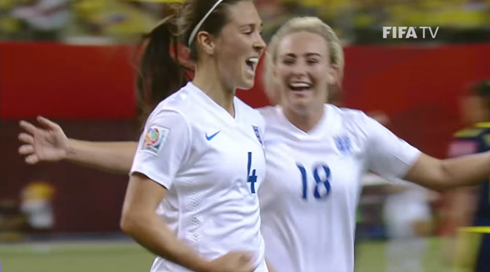In 2015 Lucy Bronze scored an insane 20-yard strike against Norway to secure a place in the World Cup Semi-Finals. The goalie lobbed her body at the spinning football but was unable to prevent it sinking into the top right-hand corner of the net. The entire England team, or ‘Lionesses’, threw their damp sweaty bodies over Bronze, screaming madly.
It was an iconic goal but one that’s apparently been forgotten by the mainstream media. Last night, as the men’s England’s World Cup team played against Croatia, Channel 4 was forced to apologise after publishing a number of reports claiming the match was the first time England been in a World Cup Semi-Final since 1990 — totally erasing Bronze and her teammate’s 2015 victory from memory.
That women’s football is largely ignored by the press is not a new thing, although it’s still depressing to hear that just 7% of all sports coverage is devoted to women’s games. People continually spew out the well-worn argument that women’s football “is just not as interesting” as men’s to justify its absence from our screens. While other commentators make far more insipid claims. In 2015 The Daily Record ran a column, “Quest to find some quality in FIFA Women’s World Cup”, slating the BBC for its “unjustified” investment in what has been a “borefest”. And only last year, crusty man factory The Daily Mail published a column, “Please stop telling us that women’s sport is as good as men’s — it isn’t”.
These men seem to believe women’s football is just a bunch of clueless scatterbrains running around pitches crying “which way are we scoring?” rather than dextrous players pinging balls around with startling accuracy without anywhere near the amount of fan support or funding male players receive.
In 2011 a leaked recording of Sky football anchors Richard Keyes and Andy Grey showed them mocking the presence of a female official at a Liverpool vs. Wolverhampton Wanderers match, suggesting that she wouldn’t “know the offside rule”. Keyes then remarked on West Ham Vice Chair Karren Brady’s new newspaper column: “The game’s gone mad. See charming Karren Brady this morning complaining about sexism? Yeah. Do me a favour, love.”
This idiotic rhetoric continues even today. Last year’s Love Island winner Amber Davis retweeted an explanation of the offside rule which used the example of buying handbags to supposedly make it clearer for women to understand. “Oh my days why haven’t I seen this earlier. NOW I UNDERSTAND,” she said as though all we care about is mindless consumerist pink fluff.
“A 2017 study found that commentary on men’s sports contained significantly more jokes and complementary action-packed, fast-paced language compared to women’s.”
I don’t get the offside rule, but that’s not because I am distracted by cute clutch bags. Rather, it’s because growing up my only encounters with football were sitting on a bench watching the boys tackle each other. While girls that did join in the game were often rarely passed. It was the same with Call of Duty and skateboarding, things were never perceived as something women really enjoyed, no they just wanted to be tomboys.
The idea that women’s football is dull is just not true, instead the issue lies with the coverage. A 2017 study found that commentary on men’s sports contained significantly more jokes and complementary action-packed, fast-paced language compared to women’s. Presenters chuckle when balls fly wide during women’s matches or patronisingly warn “steady girls” as they hold up trophies, while in men’s tournaments they yell repeatedly through gravelly throats, roaring with red-faced pride into inaudibility.
This all limits television ratings, ticket sales and the amount advertisers are willing to pay for broadcast time during women’s events. This damages the potential for corporate endorsements for women athletes and the salaries of players and coaches. A tragic example of this occurred when the Notts County women’s team disbanded operations days before the start of the season after chairman Alan Hardy said allowing them to continue would have been “financial suicide”. Thus leaving four England players adrift and, in the case of midfielder Danielle Buet, homeless.
But women’s football has not always been shrugged off. In 1920, crowds of 53,000 watched Dick, Kerr Ladies — a team formed at a munitions factory in Preston during the First World War — play a series of games. Before the FA imposed a 50-year ban on the sport, forever smearing women’s participation while men’s swelled into the money churning mega-machine it is now.
Thankfully the circumstances are improving for women’s football. In 2017 the FA invested £17m into the sport and match ratings are growing, with more than four million people watching England play the Netherlands in the semi-finals of the European Championships. These were Channel 4s highest audience figures in 2017.
Before writing this I didn’t know the name of a single women’s England player, next year when they compete in the World Cup I hope I know them all.

